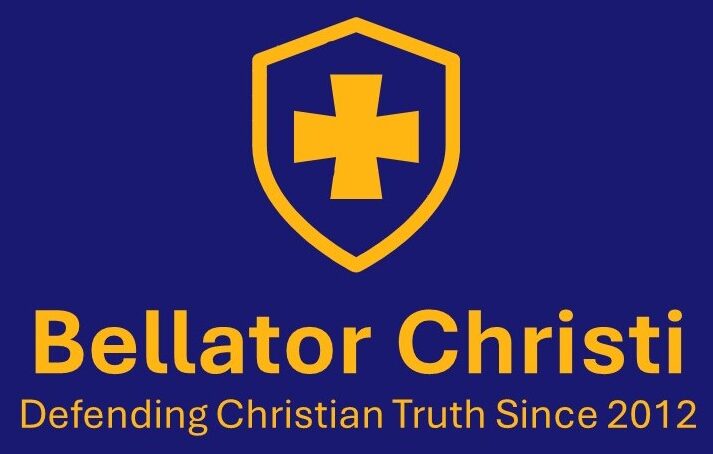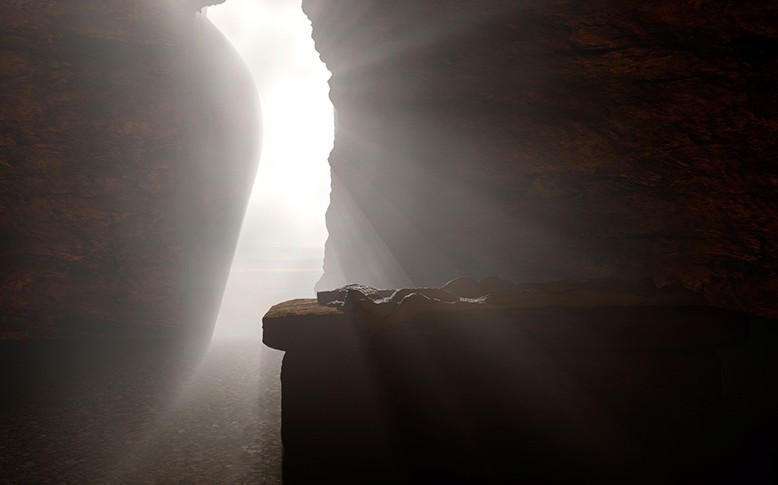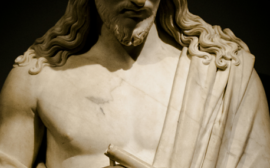Latest Research that Further Confirms the Resurrection of Jesus
By: Brian G. Chilton, M.Div., Ph.D. | April 18, 2025
Good Friday and Easter are among the two most sacred days of Christianity. While some sensationalist magazines and outlets try to cynically offer reasons to doubt or deny the events of Passion Week, ongoing research into the life of Christ and the early church only seems to further add solid reasons to accept that the New Testament is accurate in what it tells us about the life of Jesus and the origins of the church.
Three recent findings circumstantially validate the resurrection of Jesus in their own unique way. These three artifacts offer added weight to the place where Jesus was buried, the potential phenomenon surrounding his resurrection, and the early proclamation of Jesus’s resurrection as a core, central theme of the church’s Christology and identity.
Data Confirms the Place of the Resurrection
News articles around the time of Easter often surface that pose that a new burial spot for Jesus was found and often assert that Jesus’s body has been found. Recently, one researcher claimed to have found the sarcophagus of Jesus under the pyramids in Egypt. These accounts typically circulate in news agencies such as the National Enquirer and other tabloids. You know, the kind that claim that a Batboy was discovered.
Unlike these often hilarious and ridiculous claims, two sites in Jerusalem are often packaged as being the tomb of Jesus—the Garden Tomb and the Church of the Holy Sepulchre. The former holds no historical connection to the burial place of Jesus. However, the Church of the Holy Sepulrche holds a vast history connecting it to the burial place of Jesus. Since at least the 4th century AD, pilgrims venerated the site as the true burial grounds of Jesus.
Garden Between Calvary and Tomb
Interestingly, recent excavations by a team of archaeologists from Sapienza University in Rome connect the Church of the Holy Sepulchre’s authenticity by placing the tomb in the time of Jesus.[1] Since 2022, the three branches of the Church that oversee the Church of the Holy Sepulchre gave permission for the researchers to dig under the church. What the researchers found was nothing short of astounding. The team discovered a native Israeli plant that dated to AD 33, the likely date of Jesus’s crucifixion and resurrection. The Gospels assert that a garden was found between Golgotha (the site of Jesus’s crucifixion) and the tomb of Jesus (John 19:41). The plant was found between the crucifixion site and the tomb of Jesus, just as the Gospels purport.
If that weren’t enough, the research team also found marble tombs connected with Joseph of Arimathea.[2] Joseph was a member of the Sanhedrin that had Jesus executed by the Romans. Likely, Joseph was a sympathizer of Jesus and His movement. It is highly possible that he was a secret disciple of Jesus, like Nicodemus.
These findings are just the beginning of what is likely to come from the excavation site. Needless to say, people have greater reasons now than ever before to believe that the Church of the Holy Sepulchre houses the actual tomb of Jesus. Seeing that we know the highly probable place of Jesus’s burial, we can confirm, just as the first disciples, that Jesus is not in the tomb. He is risen!
Data that Confirms the Shroud of Turin as the Burial Shroud of Jesus
In late 2024, nuclear engineer Robert Rucker used a new kind of research to test the date of the Turin Shroud. For those who have not followed Shroud studies, the Shroud of Turin is a 14 ft. long by 3.5 ft. wide herringbone linen cloth that bears the faint front and back image of a crucified man. Interestingly, the scars on the man of the Shroud match the biblical depiction of Jesus of Nazareth’s crucifixion.
In the 1980s, a Carbon-14 date suggested that the Shroud dated to the medieval period, too late to be the burial Shroud of Jesus. However, the Carbon-14 date was plagued with problems, including three tests from the same piece of cloth, the tested piece of cloth coming from the most handled area of the Shroud, and the great likelihood that the piece of cloth came from the patchwork of the Poor Clare Nuns of the medieval period, who sewed fragments to the Shroud after it caught fire in an accidental church fire.
Rucker, who is a 38-year veteran of nuclear engineering, used a new form of testing to gauge the date of the Shroud.[3] The new X-Ray scattering tests indicate that the Shroud dates to within 55 BC–85 AD, placing it well within the historical period that Jesus lived.
Created by Ultraviolet Radiation
Rucker suggests that the image on the Shroud was caused by “a burst of radiation emitted from the body that [formed] the image on the Shroud … Particle radiation and electromagnetic radiation (infrared, visible, and ultraviolet light) carry momentum. When these forms of radiation hit an object, they can transfer momentum to the object and thus force it to move. An extremely intense rapid burst of radiation from the body would have the capability to force the blood off the body and thrust it onto and into the Shroud.”
He goes on to say that if “the radiation were vertically collimated, as would be needed to form the image on the cloth without a lens between the body and the cloth, the blood would be transferred vertically up and down away from the body, so that when it reached the cloth, it would still be in the configuration that it was on the body.”[4]
34 Trillion Watts?!?
It has been suggested that 34 trillion watts of ultraviolet radiation would be required to make an image like that on the Turin Shroud.[5] Thus, on the first Easter Sunday, the tomb of Jesus would have experienced a brilliant display of power and light within 1/34 of a second. I find it interesting that this data was presented at St. Thomas the Apostle since it was St. Thomas, the apostle for whom the church was named, who first doubted Jesus’s resurrection, only to become an avid, steadfast believer after seeing the risen Jesus.
While this data does not prove that the Shroud is Jesus’s gravecloth, ergo, not proving the resurrection either, it does give us good reasons to believe that the Turin Shroud is the burial cloth of Jesus. Furthermore, the Turin Shroud gives us an idea about how the resurrection could have been on the first Easter Sunday. Thereby, how the imprint was made on the cloth could give us some insights on how our own resurrection could happen when Jesus returns.
Data that Confirms the Early Worship of the Risen Jesus
Recently, the Museum of the Bible announced the unveiling of a mosaic found in Israel that dates to the third century. The early place of worship included the earliest physical evidence of the worship of Christ with the words “God Jesus Christ” next to an image of two fish.[6] Additionally, the mosaic also spoke of a Roman centurion, an artist, and five women. The mosaic underscored the diversity and the importance of a variety of patrons in the early church.
The mosaic offers a few very important insights into the resurrection of Jesus. First, the mosaic gives concrete evidence that the early church believed that Jesus had risen from the dead and worshiped him as God’s Son. Second, the mosaic supports the idea that the message of Christ’s resurrection was very early. Finally, the mosaic also highlights the unique mixture of Jews and Gentiles, males and females, and even Roman citizens and non-Roman citizens who comprised the early church.
Conclusion
As technology advances and archaeology continues its research, the believer finds more and more reasons to believe in Jesus as the Messiah. Will this evidence convince everyone? No. In the Parable of the Rich Man and Lazarus, Jesus acknowledged that not even his resurrection would convince everyone, saying “If they do not listen to Moses and the Prophets, they will not be persuaded even if someone rises from the dead’” (Lk. 16:31, NASB). Thus, we find ourselves in the similar vein of theologian Wolfhart Pannenberg’s assessment, who is said to have observed, “The evidence for Jesus’ resurrection is so strong that nobody would question it except for two things: First, it is an unusual event. And second, if you believe it happened, you have to change the way you live.”[7]
Are you willing to accept the evidence for the resurrection of Jesus and all it entails?
About the Author
Brian G. Chilton, M.Div., Ph.D.

Brian G. Chilton is the founder of Bellator Christi Ministries and the co-host of the Bellator Christi Podcast. Dr. Chilton earned a Ph.D. in the Theology and Apologetics at Liberty University (with high distinction), a M.Div. in Theology from Liberty University (with high distinction); his B.S. in Religious Studies and Philosophy from Gardner-Webb University (with honors); earned a Certificate in Christian Apologetics from Biola University, and completed Unit 1 of Clinical Pastoral Education at Wake Forest University’s School of Medicine. Dr. Chilton is a member of the Evangelical Theological Society and the Evangelical Philosophical Society.
In his spare time, he enjoys reading, working out in his home gym, and watching football. Brian has served in pastoral ministry for over 20 years, works as a clinical hospice chaplain, is an Adjunct Professor of Apologetics at Carolina College of Biblical Studies (https://www.CCBS.edu), and serves as the Editor-in-Chief of Acquisitions for Illative House Press (https://illativehousepress.com).
Notes
[1] Dario Radley, “Ancient garden found at Jesus Christ’s burial site, verifying biblical account,” ArchaeologyNewsOnlineMagazine (April 6, 2025), https://archaeologymag.com/2025/04/ancient-garden-found-at-jesus-burial-site/.
[2] Fabiana Buontempo, “Jesus’ burial spot yields new biblical clues about his death, scentists say,” NewYorkPost.com (April 1, 2025), https://nypost.com/2025/04/01/lifestyle/jesus-burial-spot-yields-new-biblical-clues-about-his-death-and-resurrection-scientists-say/.
[3] Martin Barillas, “Nuclear engineer says latest research confirms first century date of Shroud of Turin,” NCRegister.com (September 28, 2024), https://www.ncregister.com/cna/nuclear-engineer-says-latest-research-confirms-first-century-date-of-shroud-of-turin.
[4] Bob Rucker, “The Shroud Research Network: Seeking Solutions to the Mysteries of the Shroud,” ShroudResearch.net, https://www.shroudresearch.net/hproxy.php/home.html#4.
[5] Nate Cheever, “Shroud Gathers Crowd,” StillwaterLokalLife.com (April 26, 2024), https://www.stillwaterlokallife.com/shroud-gathers-crowd/.
[6] https://www.museumofthebible.org/the-inscriptions.
[7] https://www.preachingtoday.com/illustrations/2007/march/4031907.html.





